Tablet computer
A tablet computer, commonly shortened to tablet, is a mobile device, typically with a mobile operating system and touchscreen display processing circuitry, and a rechargeable battery in a single, thin and flat package. Tablets, being computers, do what other personal computers do, but lack some input/output (I/O) abilities that others have. Modern tablets largely resemble modern smartphones, the only differences being that tablets are relatively larger than smartphones, with screens 7 inches (18 cm) or larger, measured diagonally,[1][2][3][4] and may not support access to a cellular network.
The touchscreen display is operated by gestures executed by finger or digital pen (stylus), instead of the mouse, trackpad, and keyboard of larger computers. Portable computers can be classified according to the presence and appearance of physical keyboards. Two species of tablet, the slate and booklet, do not have physical keyboards and usually accept text and other input by use of a virtual keyboard shown on their touchscreen displays. To compensate for their lack of a physical keyboard, most tablets can connect to independent physical keyboards by Bluetooth or USB; 2-in-1 PCs have keyboards, distinct from tablets.
The form of the tablet was conceptualized in the middle of the 20th century (Stanley Kubrick depicted fictional tablets in the 1968 science fiction film A Space Odyssey) and prototyped and developed in the last two decades of that century. In 2010, Apple released the iPad, the first mass-market tablet to achieve widespread popularity.[5] Thereafter tablets rapidly rose in ubiquity and soon became a large product category used for personal, educational and workplace applications,[6] with sales stabilizing in the mid-2010s.[7][8][9] Popular uses for a tablet PC include viewing presentations, video-conferencing, reading e-books, watching movies, sharing photos and more.[10]
History
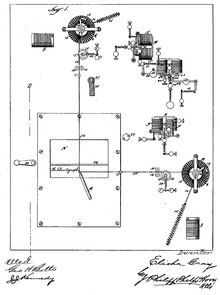
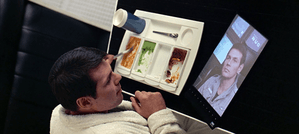
The tablet computer and its associated operating system began with the development of pen computing.[11] Electrical devices with data input and output on a flat information display existed as early as 1888 with the telautograph,[12] which used a sheet of paper as display and a pen attached to electromechanical actuators. Throughout the 20th century devices with these characteristics have been imagined and created whether as blueprints, prototypes, or commercial products. In addition to many academic and research systems, several companies released commercial products in the 1980s, with various input/output types tried out.
The development of the tablet computer was enabled by several key technological advances. The rapid scaling and miniaturization of MOSFET transistor technology (Moore's law), the basic building block of mobile devices and computing devices,[13][14] made it possible to build portable smart devices such as tablet computers.[13] Another important enabling factor was the lithium-ion battery, an indispensable energy source for tablets,[15] commercialized by Sony and Asahi Kasei in 1991.[16]
Fictional and prototype tablets
Tablet computers appeared in a number of works of science fiction in the second half of the 20th century; all helped to promote and disseminate the concept to a wider audience.[17] Examples include:
- Isaac Asimov described a Calculator Pad in his novel Foundation (1951)
- Stanisław Lem described the Opton in his novel Return from the Stars (1961)
- Numerous similar devices were depicted in Gene Roddenberry's Star Trek: The Original Series (1968)
- Arthur C. Clarke's NewsPad[18] was depicted in Stanley Kubrick's film 2001: A Space Odyssey (1968)
- Douglas Adams described a tablet computer in The Hitchhiker's Guide to the Galaxy and the associated comedy of the same name (1978)
- The science fiction TV series Star Trek: The Next Generation featured tablet computers which were designated as PADDs, notable for (as with most computers in the show) using a touchscreen interface, both with and without a stylus (1987)[19]
- A device more powerful than today's tablets appeared briefly in The Mote in God's Eye (1974)[20]
- The Star Wars franchise features datapads, first described in print in the 1991 novel, Heir to the Empire and depicted on screen in the 1999 feature film, Star Wars: The Phantom Menace
Further, real-life projects either proposed or created tablet computers, such as:
- In 1968, computer scientist Alan Kay envisioned a KiddiComp;[21][22] he developed and described the concept as a Dynabook in his proposal, A personal computer for children of all ages (1972),[23] which outlines functionality similar to that supplied via a laptop computer, or (in some of its other incarnations) a tablet or slate computer, with the exception of near eternal battery life. Adults could also use a Dynabook, but the target audience was children.
- In 1979, the idea of a touchscreen tablet that could detect an external force applied to one point on the screen was patented in Japan by a team at Hitachi consisting of Masao Hotta, Yoshikazu Miyamoto, Norio Yokozawa and Yoshimitsu Oshima, who later received a US patent for their idea.[24]
- In 1992, Atari showed developers the Stylus, later renamed ST-Pad. The ST-Pad was based on the TOS/GEM Atari ST Platform and prototyped early handwriting recognition. Shiraz Shivji's company Momentus demonstrated in the same time a failed x86 MS-DOS based Pen Computer with its own graphical user interface (GUI).[25]
- In 1994, the European Union initiated the NewsPad project, inspired by Clarke and Kubrick's fictional work.[26] Acorn Computers developed and delivered an ARM-based touch screen tablet computer for this program, branding it the "NewsPad"; the project ended in 1997.[27]
- During the November 2000 COMDEX, Microsoft used the term Tablet PC to describe a prototype handheld device they were demonstrating.[28][29][30]
- In 2001, Ericsson Mobile Communications announced an experimental product named the DelphiPad, which was developed in cooperation with the Centre for Wireless Communications in Singapore, with a touch-sensitive screen, Netscape Navigator as a web browser, and Linux as its operating system.[31][32]
Early tablets
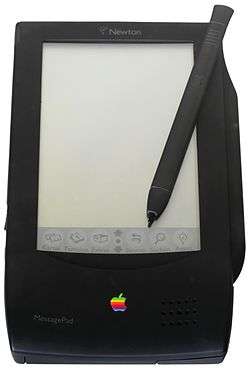
Following earlier tablet computer products such as the Pencept PenPad,[33][34] and the CIC Handwriter,[35] in September 1989, GRiD Systems released the first commercially successful tablet computer, the GRiDPad.[36][37] All three products were based on extended versions of the MS-DOS operating system. In 1992, IBM announced (in April) and shipped to developers (in October) the 2521 ThinkPad, which ran the GO Corporation's PenPoint OS. Also based on PenPoint was AT&T's EO Personal Communicator from 1993, which ran on AT&T's own hardware, including their own AT&T Hobbit CPU. Apple Computer launched the Apple Newton personal digital assistant in 1993. It used Apple's own new Newton OS, initially running on hardware manufactured by Motorola and incorporating an ARM CPU, that Apple had specifically co-developed with Acorn Computers. The operating system and platform design were later licensed to Sharp and Digital Ocean, who went on to manufacture their own variants.
In 1996, Palm, Inc. released the first of the Palm OS based PalmPilot touch and stylus based PDA, the touch based devices initially incorporating a Motorola Dragonball (68000) CPU. Also in 1996 Fujitsu released the Stylistic 1000 tablet format PC, running Microsoft Windows 95, on a 100 MHz AMD486 DX4 CPU, with 8 MB RAM offering stylus input, with the option of connecting a conventional Keyboard and mouse. Intel announced a StrongARM[38] processor-based touchscreen tablet computer in 1999, under the name WebPAD. It was later re-branded as the "Intel Web Tablet".[39] In 2000, Norwegian company Screen Media AS and the German company Dosch & Amand Gmbh released the " FreePad".[40] It was based on Linux and used the Opera browser. Internet access was provided by DECT DMAP, only available in Europe and provided up to 10Mbit/s. The device had 16 MB storage, 32 MB of RAM and x86 compatible 166 MHz "Geode"-Microcontroller by National Semiconductor.[41] The screen was 10.4" or 12.1" and was touch sensitive. It had slots for SIM cards to enable support of television set-up box. FreePad were sold in Norway and the Middle East; but the company was dissolved in 2003.
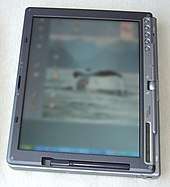
In April 2000, Microsoft launched the Pocket PC 2000, using their touch capable Windows CE 3.0 operating system.[42] The devices were manufactured by several manufacturers, based on a mix of: x86, MIPS, ARM, and SuperH hardware. In 2002, Microsoft attempted to define the Microsoft Tablet PC[43] as a mobile computer for field work in business,[44] though their devices failed, mainly due to pricing and usability decisions that limited them to their original purpose - such as the existing devices being too heavy to be held with one hand for extended periods, and having legacy applications created for desktop interfaces and not well adapted to the slate format.[45]
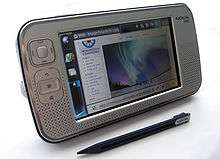
Nokia had plans for an Internet tablet since before 2000. An early model was test manufactured in 2001, the Nokia M510, which was running on EPOC and featuring an Opera browser, speakers and a 10-inch 800×600 screen, but it was not released because of fears that the market was not ready for it.[46] Nokia entered the tablet space in May 2005 with the Nokia 770 running Maemo, a Debian-based Linux distribution custom-made for their Internet tablet line. The user interface and application framework layer, named Hildon, was an early instance of a software platform for generic computing in a tablet device intended for internet consumption.[47] But Nokia didn't commit to it as their only platform for their future mobile devices and the project competed against other in-house platforms and later replaced it with the Series 60.[48] Nokia used the term internet tablet to refer to a portable information appliance that focused on Internet use and media consumption, in the range between a personal digital assistant (PDA) and an Ultra-Mobile PC (UMPC). They made two mobile phones, the N900 that runs Maemo, and N9 that run Meego.[49]
Before the release of iPad, Axiotron introduced[50] an aftermarket, heavily modified Apple MacBook called Modbook, a Mac OS X-based tablet computer. The Modbook uses Apple's Inkwell for handwriting and gesture recognition, and uses digitization hardware from Wacom. To get Mac OS X to talk to the digitizer on the integrated tablet, the Modbook was supplied with a third-party driver.[51]
Following the launch of the Ultra-mobile PC, Intel began the Mobile Internet Device initiative, which took the same hardware and combined it with a tabletized Linux configuration. Intel codeveloped the lightweight Moblin (mobile Linux) operating system following the successful launch of the Atom CPU series on netbooks. In 2010, Nokia and Intel combined the Maemo and Moblin projects to form MeeGo, a Linux-based operating system supports netbooks and tablets. The first tablet using MeeGo was the Neofonie WeTab launched September 2010 in Germany. The WeTab used an extended version of the MeeGo operating system called WeTab OS. WeTab OS adds runtimes for Android and Adobe AIR and provides a proprietary user interface optimized for the WeTab device. On September 27, 2011 the Linux Foundation announced that MeeGo would be replaced in 2012 by Tizen.[52]
Modern tablets
Android was the first of the 2000s-era dominating platforms for tablet computers to reach the market. In 2008, the first plans for Android-based tablets appeared. The first products were released in 2009. Among them was the Archos 5, a pocket-sized model with a 5-inch touchscreen, that was first released with a proprietary operating system and later (in 2009) released with Android 1.4. The Camangi WebStation was released in Q2 2009. The first LTE Android tablet appeared late 2009 and was made by ICD for Verizon. This unit was called the Ultra, but a version called Vega was released around the same time. Ultra had a 7-inch display while Vega's was 15 inches. Many more products followed in 2010. Several manufacturers waited for Android Honeycomb, specifically adapted for use with tablets, which debuted in February 2011.
Apple is often credited for defining a new class of consumer device with the iPad,[53] which shaped the commercial market for tablets in the following years,[54] and was the most successful tablet at the time of its release. iPads and competing devices were tested by the US military in 2011[55] and cleared for secure use in 2013.[56] Its debut in 2010 pushed tablets into the mainstream.[57][58] Samsung's Galaxy Tab and others followed, continuing the trends towards the features listed above. In March 2012, PC Magazine reported that 31% of U.S. Internet users owned a tablet, used mainly for viewing published content such as video and news.[59] The top-selling line of devices was Apple's iPad with 100 million sold between its release in April 2010 and mid-October 2012,[60] but iPad market share (number of units) dropped to 36% in 2013 with Android tablets climbing to 62%. Android tablet sales volume was 121 million devices, plus 52 million, between 2012 and 2013 respectively.[61] Individual brands of Android operating system devices or compatibles follow iPad with Amazon's Kindle Fire with 7 million, and Barnes & Noble's Nook with 5 million.[62][63][64]
The BlackBerry PlayBook was announced in September 2010 that ran the BlackBerry Tablet OS.[65] The BlackBerry PlayBook was officially released to US and Canadian consumers on April 19, 2011. Hewlett Packard announced that the TouchPad, running WebOS 3.0 on a 1.2 GHz Qualcomm Snapdragon CPU, would be released in June 2011. On August 18, 2011, HP announced the discontinuation of the TouchPad, due to sluggish sales.[66] In 2013, the Mozilla Foundation announced a prototype tablet model with Foxconn which ran on Firefox OS.[67] Firefox OS was discontinued in 2016.[68] The Canonical hinted that Ubuntu would be available on tablets by 2014.[69] In February 2016 there was a commercial release of the BQ Aquaris Ubuntu tablet utilizing the Ubuntu Touch operating system.[70] Canonical terminated support for the project due to lack of market interest on 5 April 2017[71][72] and it was then adopted by the UBports as a community project.[73]
As of February 2014, 83% of mobile app developers were targeting tablets,[74] but 93% of developers were targeting smartphones. By 2014 around 23% of B2B companies were said to have deployed tablets for sales-related activities, according to a survey report by Corporate Visions.[75] The iPad held majority use in North America, Western Europe, Japan, Australia, and most of the Americas. Android tablets were more popular in most of Asia (China and Russia an exception), Africa and Eastern Europe. In 2015 tablet sales did not increase. Apple remained the largest seller but its market share declined below 25%.[76] Samsung vice president Gary Riding said early in 2016 that tablets were only doing well among those using them for work. Newer models were more expensive and designed for a keyboard and stylus, which reflected the changing uses.[77] As of early 2016, Android reigned over the market with 65%. Apple took the number 2 spot with 26%, and Windows took a distant third with the remaining 9%.[78] In 2018, out of 4.4 billion computing devices Android accounted for 2 billion, iOS for 1 billion, and the remainder were PCs, in various forms (desktop, notebook, or tablet), running various operating systems (Windows, macOS, ChromeOS, Linux, etc.).[79]
Types
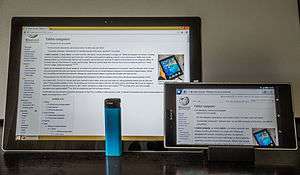
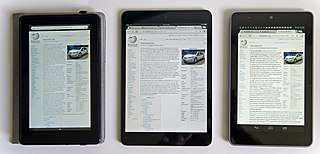
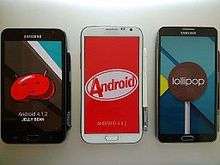
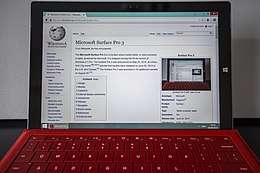
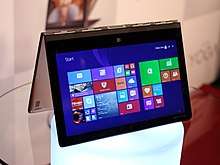
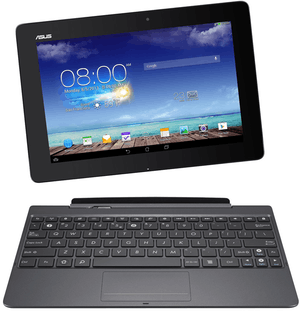
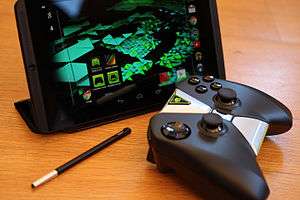
Tablets can be loosely grouped into several categories by physical size, kind of operating system installed, input and output technology, and uses.[80]
Slate
The size of a slate varies, but slates begin at 6 inches (approximately 15 cm).[81] Some models in the larger than 10-inch (25 cm) category include the Samsung Galaxy Tab Pro 12.2 at 12.2 inches (31 cm), the Toshiba Excite at 13.3 inches (33 cm)[82] and the Dell XPS 18 at 18.4 inches (47 cm).[83] As of March 2013, the thinnest tablet on the market was the Sony Xperia Tablet Z at only 0.27 inches (6.9 mm) thick.[84] On September 9, 2015, Apple released the iPad Pro with a 12.9 inches (33 cm) screen size, larger than the regular iPad.[85]
Mini tablet
Mini tablets are smaller and weigh less than slates, with typical screen sizes between 7–8 inches (18–20 cm). The first commercially successful mini tablets were introduced by Amazon.com (Kindle Fire), Barnes & Noble (Nook Tablet), and Samsung (Galaxy Tab) in 2011; and by Google (Nexus 7) in 2012. They operate identically to ordinary tablets but have lower specifications compared to them.
On September 14, 2012, Amazon, Inc. released an upgraded version of the Kindle Fire, the Kindle Fire HD, with higher screen resolution and more features compared to its predecessor, yet remaining only 7 inches.[86] In October 2012, Apple released the iPad Mini with a 7.9 inch screen size, about 2 inches smaller than the regular iPad, but less powerful than the then current iPad 3.[87] On July 24, 2013, Google released an upgraded version of the Nexus 7, with FHD display, dual cameras, stereo speakers, more color accuracy, performance improvement, built-in wireless charging, and a variant with 4G LTE support for AT&T, T-Mobile, and Verizon. In September 2013, Amazon further updated the Fire tablet with the Kindle Fire HDX. In November 2013, Apple released the iPad Mini 2, which remained at 7.9 inches and nearly matched the hardware of the iPad Air.
Phablet
Smartphones and tablets are similar devices, differentiated by the former typically having smaller screens and most tablets lacking cellular network capability. Since 2010, crossover touchscreen smartphones with screens larger than 5 inches have been released. That size is generally considered larger than a traditional smartphone, creating the hybrid category of the phablet by Forbes[88] and other publications. "Phablet" is a portmanteau of "phone" and "tablet".
At the time of the introduction of the first phablets, they had screens of 5.3 to 5.5 inches, but as of 2017 screen sizes up to 5.5 inches are considered typical. Examples of phablets from 2017 and onward are the Samsung Galaxy Note series (newer models of 5.7 inches), the LG V10/V20 (5.7 inches), the Sony Xperia XA Ultra [6 inches], the Huawei Mate 9 (5.9 inches), and the Huawei Honor (MediaPad) X2 (7 inches).
2-in-1
A 2-in-1 PC is a hybrid or combination of a tablet and laptop computer that has features of both. Distinct from tablets, 2-in-1 PCs all have physical keyboards, but they are either concealable by folding them back and under the touchscreen ("2-in-1 convertible") or detachable ("2-in-1 detachable"). 2-in-1s typically also can display a virtual keyboard on their touchscreens when their physical keyboards are concealed or detached. Some 2-in-1s have processors and operating systems like those of laptops, such as Windows 10, while having the flexibility of operation as a tablet. Further, 2-in-1s may have typical laptop I/O ports, such as USB 3 and DisplayPort, and may connect to traditional PC peripheral devices and external displays. Simple tablets are mainly used as media consumption devices, while 2-in-1s have capacity for both media consumption and content creation, and thus 2-in-1s are often called laptop or desktop replacement computers.[89]
There are two species of 2-in-1s:
- Convertibles have a chassis design by which their physical keyboard may be concealed by flipping/folding the keyboard behind the chassis. Examples include 2-in-1 PCs of the Lenovo Yoga series.
- Detachables or Hybrids have physical keyboards that may be detached from their chassis, even while the 2-in-1 is operating. Examples include 2-in-1 PCs of the Asus Transformer Pad and Book series, the iPad Pro, and the Microsoft Surface Book and Surface Pro.
Gaming tablet
Some tablets are modified by adding physical gamepad buttons such as D-pad and thumb sticks for better gaming experience combined with the touchscreen and all other features of a typical tablet computer. Most of these tablets are targeted to run native OS games and emulator games. Nvidia's Shield Tablet, with an 8-inch (200 mm) display, and running Android, is an example. It runs Android games purchased from Google Play store. PC games can also be streamed to the tablet from computers with some higher end models of Nvidia-powered video cards. The Nintendo Switch hybrid console is also a gaming tablet that runs on Nintendo Switch system software, features detachable Joy-Con controllers with motion controls and three gaming modes: table-top mode using its kickstand, traditional docked/TV mode and handheld mode.
Booklet
Booklets are dual-touchscreen tablet computers with a clamshell design that can fold like a laptop. Examples include the Microsoft Courier, which was discontinued in 2010,[90][91] the Sony Tablet P (which was considered a flop),[92] and the Toshiba Libretto W100.
Customized business tablet
Customized business tablets are built specifically for a business customer's particular needs from a hardware and software perspective, and delivered in a business-to-business transaction. For example, in hardware, a transportation company may find that the consumer-grade GPS module in an off-the-shelf tablet provides insufficient accuracy, so a tablet can be customized and embedded with a professional-grade antenna to provide a better GPS signal. Such tablets may also be ruggedized for field use. For a software example, the same transportation company might remove certain software functions in the Android system, such as the internet browser, to reduce costs from needless cellular network data consumption of an employee, and add custom package management software. Other applications may call for a resistive touchscreen and other special hardware and software.
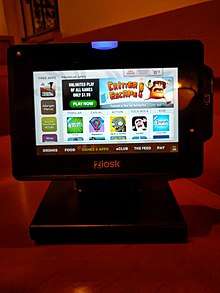
A table ordering tablet is a touchscreen tablet computer designed for use in casual restaurants.[93] Such devices allow users to order food and drinks, play games and pay their bill. Since 2013, restaurant chains including Chili's,[94] Olive Garden[95] and Red Robin[96] have adopted them. As of 2014, the two most popular brands were Ziosk and Presto.[97] The devices have been criticized by servers who claim that some restaurants determine their hours based on customer feedback in areas unrelated to service.[98]
Hardware
System architecture
Two major architectures dominate the tablet market,[99] ARM Holdings' ARM architecture and Intel's and AMD's x86. Intel's x86, including x86-64 has powered the "IBM compatible" PC since 1981 and Apple's Macintosh computers since 2006. The CPUs have been incorporated into tablet PCs over the years and generally offer greater performance along with the ability to run full versions of Microsoft Windows, along with Windows desktop and enterprise applications. Non-Windows based x86 tablets include the JooJoo. Intel announced plans to enter the tablet market with its Atom in 2010.[100][101] In October 2013, Intel's foundry operation announced plans to build FPGA-based quad cores for ARM and x86 processors.[102]
ARM has been the CPU architecture of choice for manufacturers of smartphones (95% ARM), PDAs, digital cameras (80% ARM), set-top boxes, DSL routers, smart televisions (70% ARM), storage devices and tablet computers (95% ARM).[103] This dominance began with the release of the mobile-focused and comparatively power-efficient 32-bit ARM610 processor originally designed for the Apple Newton in 1993 and ARM3-using Acorn A4 laptop in 1992. The chip was adopted by Psion, Palm and Nokia for PDAs and later smartphones, camera phones, cameras, etc. ARM's licensing model supported this success by allowing device manufacturers to license, alter and fabricate custom SoC derivatives tailored to their own products. This has helped manufacturers extend battery life and shrink component count along with the size of devices.
The multiple licensees ensured that multiple fabricators could supply near-identical products, while encouraging price competition. This forced unit prices down to a fraction of their x86 equivalents. The architecture has historically had limited support from Microsoft, with only Windows CE available, but with the 2012 release of Windows 8, Microsoft announced added support for the architecture, shipping their own ARM-based tablet computer, branded the Microsoft Surface, as well as an x86-64 Intel Core i5 variant branded as Microsoft Surface Pro.[104][105][106][107] Intel tablet chip sales were 1 million units in 2012, and 12 million units in 2013.[108] Intel chairman Andy Bryant has stated that its 2014 goal is to quadruple its tablet chip sales to 40 million units by the end of that year,[109] as an investment for 2015.[110][111][112][113]
Display
A key component among tablet computers is touch input on a touchscreen display. This allows the user to navigate easily and type with a virtual keyboard on the screen or press other icons on the screen to open apps or files. The first tablet to do this was the GRiDPad by GRiD Systems Corporation; the tablet featured both a stylus, a pen-like tool to aid with precision in a touchscreen device as well as an on-screen keyboard.[114] The system must respond to on-screen touches rather than clicks of a keyboard or mouse. This operation makes precise use of our eye–hand coordination.[115][116][117]
Touchscreens usually come in one of two forms:
- Resistive touchscreens are passive and respond to pressure on the screen. They allow a high level of precision, useful in emulating a pointer (as is common in tablet computers) but may require calibration. Because of the high resolution, a stylus or fingernail is often used. Stylus-oriented systems are less suited to multi-touch.
- Capacitive touchscreens tend to be less accurate, but more responsive than resistive devices. Because they require a conductive material, such as a fingertip, for input, they are not common among stylus-oriented devices but are prominent on consumer devices. Most finger-driven capacitive screens do not currently support pressure input (except for the iPhone 6S and later models), but some tablets use a pressure-sensitive stylus or active pen.[118]
- Some tablets can recognize individual palms, while some professional-grade tablets use pressure-sensitive films, such as those on graphics tablets. Some capacitive touch-screens can detect the size of the touched area and the pressure used.[119]
Since mid-2010s, most tablets use capacitive touchscreens with multi-touch, unlike earlier resistive touchscreen devices which users needed styluses in order to perform inputs.
There are also Electronic paper tablets such as Sony Digital Paper DPTS1 and reMarkable that use E ink for its display technology.
Handwriting recognition

Some ARM powered tablets, such as the Galaxy Note 10, support a stylus and support handwriting recognition. Wacom and N-trig digital pens provide approximately 2500 DPI resolution for handwriting, exceeding the resolution of capacitive touch screens by more than a factor of 10. These pens also support pressure sensitivity, allowing for "variable-width stroke-based" characters, such as Chinese/Japanese/Korean writing, due to their built-in capability of "pressure sensing". Pressure is also used in digital art applications such as Autodesk Sketchbook.[120][121] Apps exist on both iOS and Android platforms for handwriting recognition and in 2015 Google introduced its own handwriting input with support for 82 languages.[122]
Other features
After 2007, with access to capacitive screens and the success of the iPhone, other features became common, such as multi-touch features (in which the user can touch the screen in multiple places to trigger actions and other natural user interface features, as well as flash memory solid state storage and "instant on" warm-booting; external USB and Bluetooth keyboards defined tablets.
Most tablets released since mid-2010 use a version of an ARM processor for longer battery life. The ARM Cortex family is powerful enough for tasks such as internet browsing, light creative and production work and mobile games.[123]
Other features are: High-definition, anti-glare display, touchscreen, lower weight and longer battery life than a comparably-sized laptop, wireless local area and internet connectivity (usually with Wi-Fi standard and optional mobile broadband), Bluetooth for connecting peripherals and communicating with local devices, ports for wired connections and charging, for example USB ports, Early devices had IR support and could work as a TV remote controller, docking station, keyboard and added connectivity, on-board flash memory, ports for removable storage, various cloud storage services for backup and syncing data across devices, local storage on a local area network (LAN).
- Speech recognition Google introduced voice input in Android 2.1 in 2009 and voice actions in 2.2 in 2010, with up to five languages (now around 40).[124] Siri was introduced as a system-wide personal assistant on the iPhone 4S in 2011 and now supports nearly 20 languages. In both cases, the voice input is sent to central servers to perform general speech recognition and thus requires a network connection for more than simple commands.
- Near field communication with other compatible devices including ISO/IEC 14443 RFID tags.
Software
Operating system
Tablets, like conventional PCs, use several different operating systems, though dual-booting is rare. Tablet operating systems come in two classes:
- Desktop computer operating system
- Mobile operating system
Desktop OS-based tablets are currently thicker and heavier. They require more storage and more cooling and give less battery life. They can run processor-intensive graphical applications in addition to mobile apps, and have more ports.[125]
Mobile-based tablets are the reverse, and run only mobile apps. They can use battery life conservatively because the processor is significantly smaller. This allows the battery to last much longer than the common laptop.[126]
In Q1 2018, Android tablets had 62% of the market, Apple's iOS had 23.4% of the market and Windows 10 had 14.6% of the market.[127]
Android
Android is a Linux-based operating system that Google offers as open source under the Apache license. It is designed primarily for mobile devices such as smartphones and tablet computers. Android supports low-cost ARM systems and others. The first tablets running Android were released in 2009.[128] Vendors such as Motorola[129] and Lenovo[130] delayed deployment of their tablets until after 2011, when Android was reworked to include more tablet features.[131][132][133] Android 3.0 (Honeycomb), released in 2011 and later versions support larger screen sizes, mainly tablets, and have access to the Google Play service. Android includes operating system, middleware and key applications. Other vendors sell customized Android tablets, such as Kindle Fire and Nook, which are used to consume mobile content and provide their own app store, rather than using the larger Google Play system, thereby fragmenting the Android market.[134]
Chrome OS
Several devices that run Chrome OS came on the market in 2017–2019, as tablets, or as 2-in-1s with touchscreen and 360-degree hinge.[135]
iPadOS
The iPad runs on iPadOS. Prior to the introduction of iPadOS in 2019, the iPad ran iOS, which was created for the iPhone and iPod Touch. The first iPad was released in 2010.[136] Although built on the same underlying Unix implementation as macOS, its user interface is radically different. iPadOS is designed for touch input from the user's fingers and has none of the features that required a stylus on earlier tablets. Apple introduced multi-touch gestures, such as moving two fingers apart or together to zoom in or out, also termed pinch to zoom.[137] iPadOS and iOS are built for the ARM architecture.[138]
Windows
Following Windows for Pen Computing for Windows 3.1 in 1991, Microsoft supported tablets running Windows XP under the Microsoft Tablet PC name.[139] Microsoft Tablet PCs were pen-based, fully functional x86 PCs with handwriting and voice recognition functionality.[140] Windows XP Tablet PC Edition provided pen support. Tablet support was added to both Home and Business versions of Windows Vista and Windows 7. Tablets running Windows could use the touchscreen for mouse input, hand writing recognition and gesture support. Following Tablet PC, Microsoft announced the Ultra-mobile PC initiative in 2006 which brought Windows tablets to a smaller, touch-centric form factor.[141][142] In 2008, Microsoft showed a prototype of a two-screen tablet called Microsoft Courier, but cancelled the project.
In 2012, Microsoft released Windows 8, which features significant changes to various aspects of the operating system's user interface and platform which are designed for touch-based devices such as tablets. The operating system also introduced an application store and a new style of application optimized primarily for use on tablets.[143][144] Microsoft also introduced Windows RT, an edition of Windows 8 for use on ARM-based devices.[145] The launch of Windows 8 and RT was accompanied by the release of devices with the two operating systems by various manufacturers (including Microsoft themselves, with the release of Surface), such as slate tablets, hybrids, and convertibles.[146]
Released in July 2015, Windows 10 introduces what Microsoft described as "universal apps"; expanding on Metro-style apps, these apps can be designed to run across multiple Microsoft product families with nearly identical code—including PCs, tablets, smartphones, embedded systems, Xbox One, Surface Hub and Windows Holographic. The Windows user interface was revised to handle transitions between a mouse-oriented interface and a touchscreen-optimized interface based on available input devices—particularly on 2-in-1 PCs; both interfaces include an updated Start menu. Windows 10 replaced all earlier editions of Windows.[147][148]
Hybrid OS operation
Several hardware companies have built hybrid devices with the possibility to work with both the Windows 10 and Android operating systems.[149]
Application store
Apps that do not come pre-installed with the system are supplied through online distribution. These sources, termed app stores, provide centralized catalogs of software and allow "one click" on-device software purchasing, installation and updates.[150][151]
Mobile device suppliers may adopt a "walled garden" approach, wherein the supplier controls what software applications ("apps") are available. Software development kits are restricted to approved software developers. This can be used to reduce the impact of malware, provide software with an approved content rating, control application quality and exclude competing vendors.[152] Apple, Google, Amazon, Microsoft and Barnes & Noble all adopted the strategy. B&N originally allowed arbitrary apps to be installed,[153][154][155] but, in December 2011, excluded third parties.[156][157][158][159] Apple and IBM have agreed to cooperate in cross-selling IBM-developed applications for iPads and iPhones in enterprise-level accounts.[160] Proponents of open source software say that it violates the spirit of personal control that traditional personal computers have always provided.[161][162][163]
Sales
Around 2010, tablet use by businesses jumped, as business began to use them for conferences, events, and trade shows. In 2012, Intel reported that their tablet program improved productivity for about 19,000 of their employees by an average of 57 minutes a day.[164] In October 2012, display screen shipments for tablets began surpassing shipments for laptop display screens.[165] Tablets are increasingly used in the construction industry to look at blueprints, field documentation and other relevant information on the device instead of carrying around large amounts of paper.[166]
As of the start of 2014, 44% of US online consumers own tablets,[167] a significant jump from 5% in 2011.[168] Tablet use has also become increasingly common among children. A 2014 survey found that mobiles were the most frequently used object for play among American children under the age of 12. Mobiles were used more often in play than video game consoles, board games, puzzles, play vehicles, blocks and dolls/action figures. Despite this, the majority of parents said that a mobile was "never" or only "sometimes" a toy.[169] As of 2014, nearly two-thirds of American 2- to 10-year-olds have access to a tablet or e-reader.[170] The large use of tablets by adults is as a personal internet-connected TV.[171] A 2015 study found that a third of children under five have their own tablet device.[172] By 2017, tablet sales worldwide had surpassed sales of desktop computers,[173] and worldwide PC sales were flat for the first quarter of 2018.[174]
| 2010[175] | 2011[176] | 2012[177] | 2013[177] | 2014[178] | 2015[179] | 2016[180] | 2017[181] | 2018Q3[182][183] | |
|---|---|---|---|---|---|---|---|---|---|
| Units (million) | 17.6 | 60.0 | 116.3 | 195.4 | 216.0 (Gartner estimate) 230.1 (IDC estimate) |
206.8 | 174.8 | 163.5 | 36.4 |
| Growth (%) | 240.9 | 93.8 | 68.0 | 10.5 | -10.1 (IDC estimate) | -15.6 | -6.5 |
2010 to 2014 figures are estimated by Gartner. 2014 to 2018 figures are estimated by IDC.
By manufacturer
| Vendor | Q3 2012 | Q3 2013 | Q3 2014 | Q3 2015 | Q3 2016 | Q3 2017 | Q3 2018 |
|---|---|---|---|---|---|---|---|
| Apple | 40.2 | 29.7 | 22.1 | 19.6 | 21.5 | 25.9 | 26.6 |
| Samsung | 12.4 | 22.2 | 17.4 | 16.0 | 15.1 | 15.0 | 14.6 |
| Others | 47.3 | 49.1 | 60.9 | 64.4 | 63.4 | 59.2 | 58.8 |
Note: Others consists of small vendors with mostly less market share. 2017 and 2018 Data now breaks out Amazon, Huawei, and Lenovo: added into Others for consistency
By operating system
According to a survey conducted by the Online Publishers Association (OPA) now called Digital Content Next (DCN) in March 2012, it found that 72% of tablet owners had an iPad, while 32% had an Android tablet. By 2012, Android tablet adoption had increased. 52% of tablet owners owned an iPad, while 51% owned an Android-powered tablet (percentages do not add up to 100% because some tablet owners own more than one type).[186] By end of 2013, Android's market share rose to 61.9%, followed by iOS at 36%.[187] By late 2014, Android's market share rose to 72%, followed by iOS at 22.3% and Windows at 5.7%.[188] As of early 2016, Android has 65% marketshare, Apple has 26% and Windows has 9% marketshare.[78] In Q1 2018, Android tablets had 62% of the market, Apple's iOS had 23.4% of the market and Windows 10 had 14.6% of the market.[189]
Use
Sleep
The blue wavelength of light from back-lit tablets may impact one's ability to fall asleep when reading at night, through the suppression of melatonin.[190] Experts at Harvard Medical School suggest limiting tablets for reading use in the evening. Those who have a delayed body clock, such as teenagers, which makes them prone to stay up late in the evening and sleep later in the morning, may be at particular risk for increases in sleep deficiencies.[191] A PC app such as F.lux and Android apps such as CF.lumen[192] and Twilight[193] attempt to decrease the impact on sleep by filtering blue wavelengths from the display. iOS 9.3 includes Night Shift that shifts the colors of the device's display to be warmer during the later hours.[194]
By plane
Because of, among other things, electromagnetic waves emitted by this type of device, the use of any type of electronic device during the take-off and landing phases was totally prohibited on board commercial flights. On 13 November 2013, the European Aviation Safety Agency (EASA) announced that the use of mobile terminals could be authorized on the flights of European airlines during these phases from 2014 onwards, on the condition that the cellular functions are deactivated ("airplane" mode activated).[195] In September 2014, EASA issued guidance that allows EU airlines to permit use of tablets, e-readers, smartphones, and other portable electronic devices to stay on without the need to be in airplane mode during all parts of EU flights, however each airline has to decide to allow this behavior.[196] In the US, the Federal Aviation Administration allowed use of portable electronic devices during all parts of flights while in airplane mode in late 2013.[197]
Tourism
Some French historical monuments are equipped with digital tactile tablets called "HistoPad".[198] It is an application integrated with an IPad Mini offering an interaction in augmented and virtual reality with several pieces of the visit, the visitor being able to take control of his visit in an interactive and personalized way.
Professional use for specific sectors
Some professionals - for example, in the construction industry, insurance experts, lifeguards or surveyors - use so-called rugged shelf models in the field that can withstand extreme hot or cold shocks or climatic environments. Some units are hardened against drops and screen breakage. Satellite-connectivity-equipped tablets such as the Thorium X,[199] for example, can be used in areas where there is no other connectivity. This is a valuable feature in the aeronautical and military realms. For example, United States Army helicopter pilots are moving to tablets as electronic flight bags, which confer the advantages of rapid, convenient synchronization of large groups of users, and the seamless updating of information.[200] US Army chaplains who are deployed in the field with the troops cite the accessibility of Army regulations, field manuals, and other critical information to help with their services; however power generation, speakers, and a tablet rucksack are also necessary for the chaplains.[201]
See also
References
- Editors PC Magazine. "Definition of: tablet computer". PC Magazine. Archived from the original on July 16, 2010. Retrieved April 17, 2010.CS1 maint: extra text: authors list (link)
- Editors Dictionary.com, "tablet computer – 1 dictionary result", Dictionary.com, archived from the original on November 8, 2011, retrieved April 17, 2010CS1 maint: extra text: authors list (link)
- Erica Ogg (May 28, 2010). "What makes a tablet a tablet? (FAQ)". CNET.com.
- "Ulefone U7 7" LTPS MTK6592 Octa-Core review". IReviewChinaPhone.com. June 28, 2014. Archived from the original on October 9, 2014.
Every device with diagonal equal 7" or longer is practically tablet PC
- "iPad Available in US on April 3" (Press release). Apple. March 5, 2010. Archived from the original on July 10, 2011. Retrieved March 5, 2010.
- Chester, Brandon (March 12, 2015). "The Dell Venue 8 7000 Series Review". Anandtech. Archived from the original on March 24, 2015. Retrieved March 23, 2015.
- "Tablets Are Dying. Do You Still Need One?".
- "The tablet is dead, says analyst". August 4, 2017.
- "Where have all the tablets gone?". April 10, 2016.
- "What is a Tablet PC?". Lenovo.
- Notes on the History of Pen-based Computing on YouTube
- Gray, Elisha (July 31, 1888), Telautograph (PDF), United States Patent 386,815 (full image)
- Sahay, Shubham; Kumar, Mamidala Jagadesh (2019). Junctionless Field-Effect Transistors: Design, Modeling, and Simulation. John Wiley & Sons. ISBN 9781119523536.
- "Remarks by Director Iancu at the 2019 International Intellectual Property Conference". United States Patent and Trademark Office. June 10, 2019. Retrieved July 20, 2019.
- Williams, R. K.; Darwish, M. N.; Blanchard, R. A.; Siemieniec, R.; Rutter, P.; Kawaguchi, Y. (2017). "The Trench Power MOSFET—Part II: Application Specific VDMOS, LDMOS, Packaging, and Reliability". IEEE Transactions on Electron Devices. 64 (3): 692–712. Bibcode:2017ITED...64..692W. doi:10.1109/TED.2017.2655149. ISSN 0018-9383.
- "Keywords to understanding Sony Energy Devices – keyword 1991". Archived from the original on 4 March 2016.
- NewsPad depiction - 2001 A Space Odyssey on YouTube
- "Did Arthur C Clarke invent the iPad?". Margaret Puls. February 12, 2012. Archived from the original on August 7, 2012.
- "Star Trek PADD". Archived from the original on October 9, 2014. Retrieved June 21, 2014.
- "I keep wishing for a real tablet--one that would function as the pocket computer we described in The Mote in God's Eye".—Pournelle, Jerry (July 8, 2011). "Jerry Pournelle Is Back in the House". Archived from the original on June 14, 2014. Retrieved June 25, 2014.
- Richards, Mike (January 23, 2008). "Why the iPhone makes 2008 seem like 1968 all over again". Open2. Archived from the original on November 12, 2011.
- Steinberg, Daniel H. (April 3, 2003). "Daddy, Are We There Yet? A Discussion with Alan Kay". O'Reilly Media. Archived from the original on March 9, 2013.
- Kay, Alan (1972). "A Personal Computer for Children of All Ages". Archived from the original on March 15, 2013.
- US4389711A patent: Touch sensitive tablet using force detection Archived September 5, 2017, at the Wayback Machine
- McCracken, Harry (January 27, 2010). "The Long Fail: A Brief History of Unsuccessful Tablet Computers". Archived from the original on August 19, 2014. Retrieved August 18, 2014.
- Molina, Alfonso H. (1998). "Visions and Realities in the NewsPad Constituency". In Roger, James-Yves; Stanford-Smith, Brian; Kidd, Paul T. (eds.). Technologies for the Information Society. IOS Press. ISBN 9789051994506.
- Editors Risc User Magazine. "The Story of NewsPAD". Risc User. Archived from the original on July 14, 2014. Retrieved February 20, 2013.CS1 maint: extra text: authors list (link)
- "Bill Gates introduces Tablet PC". COMDEX. November 2000. Archived from the original on December 6, 2000.
- Page, M. (December 21, 2000). "Microsoft Tablet PC Overview". TransmetaZone. Archived from the original on October 16, 2014.
- Kuhn, Bradley M. (2010). "Free software and cellphones". Free Software Foundation. Archived from the original on September 16, 2010.
- "Ericsson, CWC develop Linux handheld PC". January 12, 2001. Archived from the original on March 4, 2016. Retrieved August 14, 2013.
- "Ericsson Forum - Infos and support". March 21, 2012. Archived from the original on March 5, 2016. Retrieved August 14, 2013.
- Users Manual for Penpad 320, Pencept, Inc., June 15, 1984, archived from the original on December 15, 2013
- Software Control at the Stroke of a Pen, Pencept, Inc., 1985, archived from the original on June 7, 2007, retrieved May 21, 2009
- Handwriter (R) GrafText (TM) System Model GT-5000, Communication Intelligence Corporation, January 15, 1985, archived from the original on December 15, 2013
- The BYTE Awards: GRiD System's GRiDPad, BYTE Magazine, Vol 15. No 1, January 12, 1990, p. 285, archived from the original on December 15, 2013
- "Tablet history dates back two decades before iPad". www.newsday.com. November 4, 2013. Archived from the original on March 6, 2016. Retrieved March 2, 2016.
- "Intel to use StrongARM in Web Tablet". Cnet. Retrieved May 29, 2013.
- Intel Web Tablet on YouTube
- Lehrbaum, Rick (August 29, 2000). "FreePad: Norway's alternative to Sweden's Screen Phone". ZDNet. Retrieved November 18, 2019.
- "Freepad Information". Archived from the original on February 8, 2002. Retrieved March 28, 2017.CS1 maint: BOT: original-url status unknown (link)
- "Microsoft Releases Pocket PC". Microsoft. Archived from the original on March 1, 2014. Retrieved May 9, 2014.
- Markoff, John (August 30, 1999). "Microsoft brings in top talent to pursue old goal: the tablet". The New York Times. Archived from the original on October 11, 2016.
- "Tablet PC: Coming to an Office Near You?". datamation.com. Archived from the original on July 22, 2012. Retrieved September 8, 2013.
- Bright, Peter (July 31, 2010). "Ballmer (and Microsoft) still doesn't get the iPad". Ars Technica. Archived from the original on May 8, 2012.
- "Nokialla oli valmis tabletti 13 vuotta sitten tältä se näytti". digitoday.fi. April 15, 2014. Archived from the original on April 16, 2014.
- Orlowski, Andrew. "Nokia's Great Lost Platform". The Register. Archived from the original on August 10, 2017.
- "Nokia's Great Lost Platform - Page 4". Archived from the original on October 28, 2012.
- "maemo.org - maemo.org: Home of the Maemo community". maemo.org. Archived from the original on May 17, 2014.
- Tiffany Boggs. "Axiotron and OWC Unveil the ModBook". TabletPCReview.com. Archived from the original on January 4, 2012.
- "TableMagic". February 3, 2013. Archived from the original on November 29, 2014.
- Sousou, Imad. "What's Next for MeeGo". meego.com. Archived from the original on October 6, 2011. Retrieved September 28, 2011.
- "The iPad's victory in defining the tablet: What it means". InfoWorld. July 5, 2011. Archived from the original on January 18, 2012.
- Gilbert, Jason (August 19, 2011). "HP TouchPad Bites The Dust: Can Any Tablet Dethrone The IPad?". Huffington Post. Archived from the original on December 6, 2011.
- "Taking iPads into battle". Los Angeles Times. Retrieved June 30, 2013.
- Whittaker, Zack (May 17, 2013). "iPhones, iPads cleared for U.S. military use; DOD fortifies cloud". ZDNet. Archived from the original on December 8, 2015. Retrieved December 30, 2015.
- Roger Kay on Intel and Microsoft, as quoted April 29, 2011: "Clearly, each one is looking at a post-PC world..." MarketWatch Archived May 2, 2011, at the Wayback Machine
- Parrish, Kevin (October 28, 2010). "Microsoft's Ray Ozzie sees Post-PC world". Tom's Hardware US.
It's important that all of us ... form a realistic picture of what a post-PC world would actually look like ... Those who can envision a plausible future that's brighter than today will earn the opportunity to lead [in the market].
- Moscaritolo, Angela (June 18, 2012). "Survey: 31 Percent of U.S. Internet Users Own Tablets". PC Magazine. Archived from the original on October 14, 2012. Retrieved October 20, 2012.
- Chen, Brian X. (October 23, 2012). "Apple, Facing Competition, Introduces a Smaller iPad of no significant change". The New York Times. Archived from the original on February 16, 2013. Retrieved October 24, 2012.
- "Android races past iOS to tablet number one, but there's no budging Apple from the top slot". Archived from the original on November 6, 2014. Retrieved November 21, 2014.
Android is dominating tablet sales but Apple is still the biggest brand
- Chen, Brian X. (October 19, 2012). "How Are 7-Inch Tablets Doing?". The New York Times. Archived from the original on October 22, 2012. Retrieved October 20, 2012.
- Poeter, Damon (December 27, 2012). "Non-Apple Tablets Making Small Gains on iPad | News & Opinion". PCMag.com. Archived from the original on June 5, 2013. Retrieved July 8, 2013.
- "Massacre of the tablets | FP Tech Desk | Financial Post". Business.financialpost.com. December 24, 2011. Archived from the original on June 19, 2013. Retrieved June 14, 2013.
- BlackBerry PlayBook preview on YouTube BlackBerry PlayBook announcement September 27, 2010 on YouTube
- "HP Webcast announcing the end of Touchpad, webOS devices" (Press release). Retrieved August 18, 2011.
- Palladino, Valentina (January 17, 2014). "Mozilla is testing the first Firefox OS tablet prototype". The Verge. Archived from the original on February 1, 2014.
- Hoffman, Chris (September 28, 2016). "Mozilla is stopping all commercial development on Firefox OS". PC World. Archived from the original on January 16, 2017.
- "Ubuntu coming to tablets, phones and smart TVs by 2014". Archived from the original on December 7, 2011.
- "The first Ubuntu tablet is here: meet the Aquaris M10". Stuff. February 5, 2016.
- Sneddon, Joey (April 5, 2017). "Ubuntu 18.04 To Ship with GNOME Desktop, Not Unity". OMG Ubuntu. Retrieved April 5, 2017.
- Shuttleworth, Mark. "Growing Ubuntu for Cloud and IoT, rather than Phone and convergence". Canonical. Retrieved April 5, 2017.
- Tiwari, Aditya (April 6, 2017). "Unity 8 And Ubuntu Touch Aren't Going Away Completely, UBports Team Will Keep Them Alive". Retrieved April 7, 2017.
- W3C Interview: Vision Mobile on the App Developer Economy with Matos Kapetanakis and Dimitris Michalakos Archived June 29, 2016, at the Wayback Machine. February 18, 2014. Retrieved February 24, 2015.
- "1 in 4 B2B Companies Report Use of Tablets to Aid Sales-Related Activities". MarketingCharts. February 19, 2014. Archived from the original on August 16, 2014. Retrieved August 20, 2014.
- "iPad loses marketshare as tablet market shrinks". Network World. July 30, 2015. Archived from the original on March 4, 2016. Retrieved January 3, 2016.
- "The consumer tablet is dying; long live the business tablet". CTV News. April 19, 2017. Archived from the original on April 20, 2017. Retrieved April 19, 2017.
- Jordan, Greg (August 2, 2016). "IDC releases Q2 tablet PC marketshare, Windows still trails iOS and Android". MSPoweruser. Archived from the original on January 9, 2017.
- Harris, Robin (November 28, 2018). "The most popular PC is in your pocket". ZDNet.
- "Various Types of Tablets". Pinig. Archived from the original on October 3, 2016. Retrieved September 11, 2016.
- Franklin, Eric (October 30, 2012). "Tablets buying guide | Tablets - CNET Reviews". Reviews.cnet.com. Archived from the original on September 23, 2011. Retrieved June 14, 2013.
- Franklin, Eric (April 10, 2012). "The Toshiba Excite 13 sports the largest tablet screen yet | Android Atlas - CNET Reviews". Reviews.cnet.com. Archived from the original on July 11, 2013. Retrieved June 14, 2013.
- King, Charles. "Dell's XPS 18 is the latest 'big tablet' innovation". TabTimes. Archived from the original on March 17, 2013. Retrieved June 30, 2013.
- "Xperia™ Tablet Z | Waterproof and dustproof tablet". Sony. March 26, 2013. Retrieved December 15, 2014.
- "iPad Pro". Apple. Archived from the original on September 11, 2015. Retrieved September 9, 2015.
- Kelly, Heather & Gross, Doug (September 6, 2012). "Amazon announces new wave of Kindles". CNN Tech. Archived from the original on December 1, 2012. Retrieved December 2, 2012.CS1 maint: uses authors parameter (link)
- "Events". Apple. Archived from the original on June 14, 2013. Retrieved June 14, 2013.
- Kay, Roger. "5" Is the market ready for a 'phablet'?". Forbes. Archived from the original on July 29, 2017.
- "Here Come the Hybrid 'Laplets.' Should You Care?". Wired. October 17, 2012. Archived from the original on August 13, 2014. Retrieved August 13, 2014.
- Dubie, Denise (April 29, 2010). "Microsoft kills courier tablet project: Apple's iPad influence likely crushes Microsoft tablet". NetworkWorld. Archived from the original on October 9, 2014.
- Keller, Mike (April 29, 2010). "Microsoft Courier Tablet Canceled!: Gizmodo reports today that Microsoft's much-hyped Courier tablet has been canceled". PC World. Archived from the original on October 6, 2014.
- "The 8 biggest product flops of 2012 (#4)". Marketwatch. Archived from the original on July 30, 2013. Retrieved June 30, 2013.
- "Tabletop tablets speed up restaurant service". CBS News. September 22, 2014. Archived from the original on May 10, 2016. Retrieved December 16, 2016.
- Konrad, Alex (September 17, 2013). "Chili's To Install Tablets At Every Table: More Tips But A Cloudier Future For Servers". Forbes. Archived from the original on July 6, 2017.
- Lien, Tracey (April 14, 2015). "Olive Garden rolls out tabletop tablets for ordering and payment". Los Angeles Times. Archived from the original on August 17, 2016.
- Jennings, Lisa (February 13, 2015). "Red Robin to roll out tabletop tablets systemwide". Nation's Restaurant News. Archived from the original on July 16, 2016.
- Huet, Ellen (April 14, 2014). "Ordering a meal and more on tabletop tablets". SFGate. Archived from the original on June 14, 2014. Retrieved April 30, 2017.
- O'Donovan, Caroline (June 21, 2018). "Here's How That Tablet On The Table At Your Favorite Restaurant Is Hurting Your Waiter". BuzzFeed News. Retrieved June 23, 2018.
- "Intel has ARM in its crosshairs". CNET. CBS Interactive.
- "Intel shows pricing pressures for Atom due to competition from ARM". Archived from the original on October 19, 2010. Retrieved October 17, 2010.
- Gareth Halfacree (November 22, 2010). "Intel launches FPGA-equipped Atom". Archived from the original on November 27, 2010. Retrieved November 23, 2010.
- Brooke Crothers (November 3, 2013). "Intel on track to build two chips with ARM inside".
- Jeff Chu (December 18, 2012). "Where's ARM at CES?". Archived from the original on March 7, 2013.
- "Apple iPad Price, Features Say "ARM" All Over". bnet. Archived from the original on August 23, 2010.
- Tim Barjarin (July 16, 2012). "ARM vs. Intel: How the Processor Wars Will Benefit Consumers". Archived from the original on September 12, 2012.
- "The Economist - Space invaders, America's Intel and Britain's ARM have long dominated different bits of the global chip market. Now each is attacking the other's stronghold". January 7, 2012. Archived from the original on September 12, 2012.
- "Processors". arm.com. Archived from the original on August 24, 2012.
- John Morris (November 22, 2014). "What we learned about Intel this week". Archived from the original on November 24, 2014. Retrieved November 22, 2014.
- "Intel Chairman: "We Seemed to Have Lost Our Way"". November 21, 2013. Archived from the original on November 21, 2013. Retrieved November 21, 2013.
- Eassa, Ashraf (December 21, 2013). "Intel's 40 Million Tablet Campaign Seems Negative for ARM". Archived from the original on December 22, 2013. Retrieved December 23, 2013.
- Crothers, Brooke (January 18, 2014). "Behind in tablets, Intel pays firms to use its chips: Why is Intel confident that 40 million tablets will ship in 2014 with its Bay Trail processors? Here's one good reason". Archived from the original on April 19, 2014. Retrieved April 17, 2014.
Intel is sacrificing 1.5% in fiscal year 2014 profit to increase its market share in tablet computers
- Randewich, Noel (September 9, 2014). "Intel's CEO says its costly tablet chip strategy has paid off". Archived from the original on September 9, 2014. Retrieved September 9, 2014.
In the second quarter, Intel's mobile and communications unit revenue fell to 51 million dollars, and lost 1.12 billion dollars in the quarter
- Fried, Ina (November 20, 2014). "Intel Probably Won't Reach 70 Million Tablet Chips Next Year, CEO Says". Archived from the original on November 23, 2014. Retrieved November 22, 2014.: Mobile operating losses will be approximately $4 billion, and $3.2 billion in 2014, and 2015, respectively.
- Jeff Hawkins: Barnett, Shawn. "Jeff Hawkins". Pen Computing Magazine. Archived from the original on November 5, 2013.
- "Best Buy: iPad cutting into laptop sales". CNET. CBS Interactive. Archived from the original on June 17, 2011.
- "Notebook sales growth goes negative. Can we blame the iPad yet?". Fortune. Archived from the original on September 18, 2010.
- Benjamin Pimentel. "Apple's Mac sales not slowed by iPad". MarketWatch. Archived from the original on October 15, 2010.
- "Pro Pen for Surface Pro and Surface Pro 2 | Handwriting on Surface Pro and Surface Pro 2". www.microsoft.com. Archived from the original on December 28, 2015. Retrieved December 31, 2015.
- Buxton, Bill. Multitouch Overview Archived October 2, 2012, at the Wayback Machine
- "China using keyboards versus tablet input". Retrieved September 13, 2018.
- "Annotated Bibliography in On-line Character Recognition, Pen Computing, Gesture User Interfaces and Tablet and Touch Computers". ruetersward.com. Archived from the original on December 15, 2013.
- Thorp-Lancaster, Dan (April 15, 2015). "Google releases new Handwriting Input keyboard with support for 82 languages". Android Central. Archived from the original on December 18, 2015. Retrieved December 30, 2015.
- The Coming War: ARM versus x86 Archived October 18, 2010, at the Wayback Machine Mirror for: The Bright Side of News April 8, 2010
- Raphael, JR (August 12, 2010). "First look: Google's new Voice Actions for Android". Computerworld. Archived from the original on April 21, 2016. Retrieved December 30, 2015.
- "Microsoft Surface Pro review". engadget. Archived from the original on June 10, 2013. Retrieved June 16, 2013.
- Westover, Brian (October 26, 2014). "Laptops vs. Tablets: The Ultimate Showdown". PCmag.com.
- "Strategy Analytics: Tablet Market Falls 7 Percent in Q1 2018 while Top Vendors Play to Strengths". Strategy-Analytics. Retrieved October 7, 2018.
- "9 Upcoming Tablet Alternatives to the Apple iPad". Mashable. Archived from the original on August 5, 2010. Retrieved August 7, 2010.
- "digits: Motorola Plans Tablet Device". marketwatch.com. September 16, 2010. Archived from the original on September 28, 2010.
- "Lenovo is waiting for Honeycomb". October 24, 2010. Archived from the original on October 26, 2010. Retrieved October 24, 2010.
- Lyons, Daniel (October 11, 2010). "The successor to Gingerbread, Android project Honeycomb is targeted for tablet computers". Newsweek. p. 49.
- "Google demonstrated Android Honeycomb Tablet". December 7, 2010. Archived from the original on December 10, 2010.
- Andy Rubin's demo of Motorola Honeycomb tablet
- Wilcox, Joe (April 28, 2012). "Google has lost control of Android". Beta News. Archived from the original on September 13, 2012.
- Gordon Gottsegen (January 4, 2018). "Asus debuts new Chrome OS tablet, Chromebooks geared toward the classroom".
- "iPad Available in US on April 3" (Press release). Apple. March 5, 2010. Retrieved March 5, 2010.
- "Six Years Ago, Apple Made a Crowd Gasp With Pinch to Zoom and Swiping". Archived from the original on July 4, 2013. Retrieved June 12, 2013.
- "Apple tablet rumors redux: 10.7-inch display, iPhone OS underneath". Engadget. Archived from the original on February 14, 2010. Retrieved August 6, 2010.
- "Microsoft Tablet PC". Microsoft. Microsoft. Archived from the original on December 6, 2011.
- "Tablet PC Brings the Simplicity of Pen and Paper to Computing". November 13, 2000. Archived from the original on May 14, 2016.
- "Live from Steve Ballmer's CES 2010 keynote". Engadget. Archived from the original on July 12, 2010. Retrieved August 4, 2010.
- "Initial Windows 7 tablets are slated to appear during holiday 2010 season". Retrieved October 19, 2010.
- Einstein, Dave (October 11, 2012). "Microsoft Betting BIG on Cloud with Windows 8 and Tablets". Forbes. Archived from the original on October 13, 2012. Retrieved October 27, 2012.
- Miller, Michael. "Build: More Details On Building Windows 8 Metro Apps". PC Magazine. Archived from the original on February 17, 2012. Retrieved February 10, 2012.
- Gara, Tom (October 27, 2012). "What Does the 'RT' In Windows RT Stand For?". Wall Street Journal. Archived from the original on July 26, 2013. Retrieved July 10, 2013.
- "Best Windows 8 tablets: all the Windows 8 tablets we've reviewed". Tech Radar. Archived from the original on June 6, 2013. Retrieved June 12, 2013.
- Gralla, Preston (November 25, 2013). "Microsoft confirms Windows RT will die". Computerworld.
- Foley, Mary Jo (November 25, 2013). "Microsoft aims to whittle Windows variants on mobile". Archived from the original on November 28, 2013. Retrieved November 18, 2019.
- "Scenes from the Sabu sentencing: "I'm not the same person you saw three years ago." Microsoft really is "all in" on the cloud, but is IT going to follow? Top ISPs threaten to innovate less, spend less on network upgrades Google and Microsoft are out to stop dual-boot Windows/Android devices". Ars Technica. March 14, 2014. Archived from the original on June 4, 2014. Retrieved June 2, 2014.
- Poeter, Damon (December 27, 2012). "Non-Apple Tablets Making Small Gains on iPad". PC Magazine.
- Hartley, Matt (December 24, 2011). "Massacre of the tablets". Financial Post. Archived from the original on June 19, 2013.
- This "vicious cycle" (slow hardware development masking slow hardware, causing slow response, causing slow software development, causing sluggish performance at an unrealistic price, causing sluggish sales) serves only to impede further software investment. "HP reboots to confront Tablet Effect" Barron's, August 20, 2011
- Carr, Austin (December 17, 2011). "Kindle Fire Vs. Nook Tablet: "Choice" And Trash Talk". fastcompany.com. Archived from the original on January 22, 2012. Retrieved March 28, 2012.
- Mack, Eric (December 22, 2011). "How to root the Nook Tablet". Gizmag.com. Archived from the original on May 24, 2012. Retrieved March 28, 2012.
- Nita, Sorin (November 17, 2011). "Nook Tablet Can Sideload Android Apps without Needing Root". news.softpedia.com. Archived from the original on January 1, 2012. Retrieved March 28, 2012.
- Smith, Peter (December 21, 2011). "Kindle Fire and Nook Tablet both get 'upgraded' with reduced functionality". IT World. Archived from the original on January 8, 2012. Retrieved January 10, 2012.
- Verry, Tim (December 21, 2011). "Kindle Fire and Nook Tablet Receive Root Access Killing Software Updates". PCPerspective.com. Archived from the original on August 15, 2012. Retrieved January 10, 2012.
- Parishon, Joseph (December 20, 2011). "Nook Tablet firmware update 1.4.1 disables sideloading apps". The Verge. Archived from the original on April 10, 2012. Retrieved March 28, 2012.
- Wolverton, San Jose Mercury News, Troy (November 25, 2011). "Barnes & Noble's new Nook Tablet doesn't measure up to Kindle Fire: Barnes & Noble's latest digital tablet may be an upgrade to the Nook Color, but is not as strong as Amazon.com's Kindle Fire". Seattle Times. Archived from the original on March 16, 2012. Retrieved March 28, 2012.
- Hesseldahl, Arik (July 15, 2014). "Apple and IBM Team Up to Push iOS in the Enterprise". Archived from the original on July 15, 2014. Retrieved July 15, 2014.
- Brown, Peter (January 27, 2010). "iPad is iBad for freedom". Free Software Foundation. Archived from the original on December 10, 2011.
- Cherry, Steven (March 30, 2010). "The iPad Is Not a Computer". IEEE Spectrum. Archived from the original on September 30, 2012.
- Conlon, Tom (January 29, 2010). "The iPad's Closed System: Sometimes I Hate Being Right". Popular Science. Archived from the original on April 20, 2010.
- Stevenson, Kim. "Intel IT Performance Report" (PDF). Intel. Archived (PDF) from the original on June 11, 2014.
- "Tablet display shipments jump, top laptops in October". CNET. CBS Interactive. Archived from the original on November 25, 2012.
- "How Tablet Computers Changed the Construction Industry". Fortune. Archived from the original on January 11, 2017. Retrieved January 10, 2017.
- "US Tablet Ownership Update, January 2014". marketingcharts.com. January 31, 2014. Archived from the original on July 31, 2014.
- Fingas, Jon (February 11, 2014). "Two-thirds of Americans now have smartphones". Archived from the original on February 21, 2014.
- The Michael Cohen Group (February 17, 2014). "Touch Screens" (PDF). Archived from the original (PDF) on March 3, 2014.
- "Are Touchscreens Melting Your Kid's Brain? - WIRED". WIRED. April 15, 2014. Archived from the original on April 17, 2017.
- "More People Now Watch TV And Movies On Tablets In Bedrooms Than On TVs!". Business Insider. March 21, 2013. Archived from the original on July 9, 2014.
- Coughlan, Sean (October 6, 2015). "Tablet computers 'widely used by under-fives'". BBC News. Archived from the original on October 7, 2015.
- "Despite Steady Commercial Uptake, Personal Computing Device Market Expected to Decline at a -1.8% CAGR through 2022, According to IDC". IDC. February 28, 2018.
- Condon, Stephanie (April 11, 2018). "Worldwide PC shipments effectively flat in Q1 2018". ZDNet.
- "Gartner Says Apple Will Have a Free Run in Tablet Market Holiday Season as Competitors Continue to Lag". Gartner. September 22, 2011. Archived from the original on May 24, 2014. Retrieved May 23, 2014.
- "Gartner Says Worldwide Media Tablets Sales to Reach 119 Million Units in 2012". Gartner. April 10, 2012. Archived from the original on May 24, 2014. Retrieved May 23, 2014.
- "Gartner Says Worldwide Tablet Sales Grew 68 Percent in 2013, With Android Capturing 62 Percent of the Market". Gartner. March 3, 2014. Archived from the original on April 17, 2014. Retrieved April 17, 2014.
- "Gartner Says Tablet Sales Continue to Be Slow in 2015". Gartner. January 5, 2015. Archived from the original on February 8, 2015. Retrieved February 8, 2015.
- "IDC: Tablet shipments decline 10.1% in 2015, leaders Apple and Samsung both lose market share". February 1, 2016.
- "Tablet Market Woes Continue as Growth in Detachable Tablets Takes Its First Vacation During the Holiday Season, According to IDC". IDC. February 2, 2017.
- Jon Russell. "Apple continues to dominate the tablet market as sales decline once again". TechCrunch.
- "Tablet Market Sees Modest Decline of 8.6% as Slate and Detachable Categories Continue to Struggle, According to IDC" (Press release). IDC. November 2, 2018.
- IDC (30 Jan 2020) Worldwide Tablet Shipments Continue to Decline in Q4 2019, According to IDC
- "ASUS and Samsung gain wide swaths of tablet market share in Q3". October 30, 2013. Archived from the original on November 2, 2013.
- "iPad Market share analysis". October 31, 2013. Archived from the original on December 5, 2013.
- "Survey: 31 Percent of U.S. Internet Users Own Tablets". PCMAG. Archived from the original on October 14, 2012.
- "Android races past iOS to tablet number one, but there's no budging Apple from the top slot". ZDNet. Archived from the original on November 6, 2014.
- "Apple rules global tablet market with 22.3% share: Strategy Analytics". November 14, 2014. Archived from the original on October 11, 2016. Retrieved November 18, 2019.
- "Strategy Analytics: Tablet Market Falls 7 Percent in Q1 2018 while Top Vendors Play to Strengths". Strategy-Analytics. Retrieved October 7, 2018.
- Johnson, Russ (December 24, 2013). "Blue Light Blues? Three Apps to Fix Screen Tint – And Jet Lag". A New Doman. Archived from the original on December 29, 2013.
- "E-readers 'damage sleep and health,' doctors warn". Archived from the original on December 23, 2014. Retrieved December 22, 2014.
- "CF.Lumen". Alternative to. Archived from the original on December 18, 2015. Retrieved January 3, 2016.
- Rehman, Abdur Rehman · (2013). "Keep you healthy sleep using Android Devices – Twilight Health App Review". Androidegis. Archived from the original on March 4, 2016.
- "A better experience every day. And night". Apple. Archived from the original on April 17, 2016. Retrieved April 17, 2016.
- "EASA allows use of Electronic Devices on board" (Press release). European Aviation Safety Agency. November 13, 2013.
- "EASA: Phones and Tablets Can Now Stay Connected Throughout Flight". September 29, 2014.
- Lazo, Luz; Berman, Mark (October 31, 2013). "FAA to relax rules on personal electronic devices while in flight". The Washington Post.
- "La réalité augmentée de l'Histopad révolutionne la Conciergerie - Les Echos". www.lesechos.fr (in French). December 17, 2016. Retrieved September 24, 2018.
- "Thorium X - Rugged Iridium tablet". www.thoriumxtablet.com. Retrieved September 24, 2018.
- Sgt. Ashton Hofmeister (February 6, 2019). "Combat aviation brigade transitions to electronic flight bags".
- Ms. Jane Benson (CCDC SC) (December 19, 2019). "Information papers offer practical guidance on providing all-important religious support to Soldiers". U.S. Army.
External links

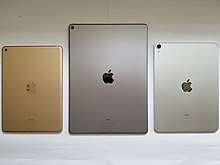
.svg.png)
